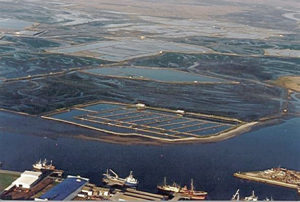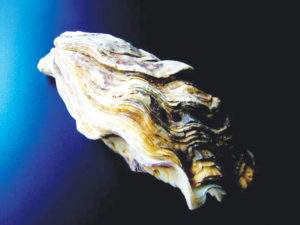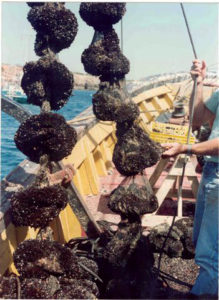Grooved clams dominate small industry

In Portugal, aquaculture production reflected only 5.4 percent of the total volume produced by the country’s declining capture fisheries in 2007. Of this percentage, mollusk farming in coastal waters focuses mainly on clams (Ruditapes decussatus), oysters (Crassotrea angulata, C. gigas, Ostrea edulis) and mussels (Mytilus edulis). Most of the shellfish industry is located on the country’s southern coast, particularly in the Algarve region.
Commercial production of bivalve mollusks uses a variety of production systems, including so-called “viveiros” or inshore, man-made culture beds, and offshore systems like long lines and rafts. Oysters are also raised in earthen ponds at fish farms, which collect wild seedstock from natural sea beds. Table 1 shows the rounded annual aquaculture production of major mollusk species in Portugal.
Afonso, Aquaculture production in metric tons of major mollusk species, Table 1
| Species | 1999 | 2000 | 2001 | 2002 | 2003 | 2004 | 2005 | 2006 |
|---|---|---|---|---|---|---|---|---|
| Grooved carpet shell clams | 1,380 | 2,416 | 2,723 | 3,094 | 3,186 | 2,011 | 1,647 | 2,335 |
| Carpet clams | 6 | 1 | 1 | |||||
| Cockles | 114 | 131 | 39 | 47 | 23 | 4 | 79 | 115 |
| Oysters | 754 | 546 | 955 | 420 | 417 | 432 | 522 | 680 |
| Mussels | 287 | 273 | 213 | 424 | 279 | 192 | 276 | 372 |
| Razor clams | 2 | 1 |
Aquaculture development

Aquaculture of marine and brackish water species in Portugal was done traditionally in inland coastal waters, estuaries and coastal lagoons using extensive regimes of production. Since the 1970s, a progressive and continuous decreasing of salt production has resulted in the abandonment of many hectares of salt pans built centuries ago in marsh lands. This land is slowly being converted to aquaculture farms.
Recently, integrated polyculture with mollusks and fish has proven successful at these farms. In fact, the use of salt industry infrastructure like ponds, dikes and water gates for marine aquaculture has become a cheap and easy process to recover the abandoned properties in productive units with fewer environmental impacts.
A modern aquaculture industry has developed in recent years, including nurseries, hatcheries and growout facilities for fish and shellfish species. Based on local technology improvements, the productivity and product quality from these semi-intensive ponds has significantly improved.
Mollusk production
The harvesting of bivalve mollusks has been an important component of Portugal’s fisheries since ancient times. The flat oyster (Ostrea edulis) was the main species in value and tonnage until 1900. It was replaced in importance by the Portuguese oyster (Crassostrea angulata) until the 1970s and then by the grooved carpet shell clam (Ruditapes decussatus). Currently, Portuguese production of marine bivalves is strongly dominated by the grooved carpet shell clam, followed by Japanese and Portuguese cupped oysters, and mussels.

The traditional utilization of natural beds is an important gathering activity that sends not only commercial-size bivalves but most of the seed used in the cultivation facilities to market. Including the species named above, several bivalve species are cultured in estuaries, lagoons and “rias” or estuaries formed in flooded river valleys.
The most important and traditional cultivation approach for clams is the intertidal viveiro culture bed, prepared to receive and grow seedstock to commercial size (Table 2). The use of trays and pouches is becoming more popular for oyster culture in subtidal and intertidal area.
Afonso, Number of saltwater and freshwater farms in Portugal, Table 2
| Saltwater Intensive | Saltwater Semi-Intensive | Saltwater Extensive | Freshwater Intensive | Freshwater Semi-Intensive | Freshwater Extensive |
|
|---|---|---|---|---|---|---|
| Reproduction units | 9 | 13 | 2 | |||
| Man-made culture beds | 1,279 | |||||
| Tanks | 10 | 76 | 53 | 17 | 2 | |
| Floating cages | 3* | 20** | 1* |
* Fish ** Bivalve mollusks
Despite the rough conditions of the Portuguese coastline, which is rather exposed and lacks natural shelters such as bays or barrier islands to protect the shore from stormy conditions prevalent during most of the year, new producing systems using suspended rafts or long lines are emerging in offshore areas as an alternative to land-based facilities. The systems grow mostly mussels and oysters.
Production constraints
Mollusk aquaculture in Portugal, like elsewhere, has much potential and high expectations. But a number of challenges, including price variations, strong international competition, and changing consumer needs and expectations, face the industry. Mortality issues from perkinsiosis of carpet shell clams and summer mortalities of Japanese oysters are production constraints that must be efficiently addressed before mollusk aquaculture’s full potential can be realized.
(Editor’s Note: This article was originally published in the March/April 2009 print edition of the Global Aquaculture Advocate.)
Now that you've finished reading the article ...
… we hope you’ll consider supporting our mission to document the evolution of the global aquaculture industry and share our vast network of contributors’ expansive knowledge every week.
By becoming a Global Seafood Alliance member, you’re ensuring that all of the pre-competitive work we do through member benefits, resources and events can continue. Individual membership costs just $50 a year. GSA individual and corporate members receive complimentary access to a series of GOAL virtual events beginning in April. Join now.
Not a GSA member? Join us.
Authors
-
Fernando Afonso, Ph.D.
Centro de Investigação Interdisciplinar
em Sanidade Animal
Faculdade de Medicina
Veterinária
Lisboa, Portugal[116,112,46,108,116,117,46,118,109,102,64,111,115,110,111,102,97,102]
-
Francisco Ruano
Inst. de Investigação das Pescas e do Mar
Aquaculture Department
Lisboa, Portugal
Tagged With
Related Posts

Responsibility
COEXIST project addresses uses, interactions in Europe’s coastal waters
Throughout Europe, debate is taking place as to whether new fish farms, wind farms, tourist facilities or marine and/or coastal protected areas should be established. Competition for space is increasing. In the COEXIST project, partners from 10 European countries are exploring these developments, aiming to increase synergies and reduce conflicts, particularly with regard to the fields of aquaculture and fisheries.

Innovation & Investment
Can IoT tool help fish farmers sleep better at night?
Berlin-based Monitorfish wants to enable fish farmers to keep a close watch on their stocks from their smartphones, another Internet of Things solution for producers.

Health & Welfare
Algae shows promise as alternative DHA source in rainbow trout diets
A growth trial in Canada evaluated the use of algae biomass to increase the concentration of long-chain polyunsaturated fatty acids in the tissues of rainbow trout.

Intelligence
Aquaculture 2016: Examining the industry’s role in the food system
A wide range of important topics was discussed at the Aquaculture 2016 conference and trade show in Las Vegas last week. Editor Emeritus Darryl Jory shares his notes from the four-day event, which occurs every three years.


